8.4 Topography and Landforms
Topography of the sea floor
Oceans cover 71% of Earth’s surface and hold 97% of Earth’s water. The water the oceans hold is critical to plate tectonics, volcanism, and, of course, life on Earth. We know more about the surface of the Moon than the floor of the oceans. Whether this is true or not, the critical point is that the ocean floor is covered with an average of nearly 4,000 m of water, and it is pitch black below a few hundred meters, so it is not easy to discover what is down there. We know a lot more about the oceans than we used to, but there is still a great deal more to discover. (4)
Earth has had oceans for a very long time, dating back to the point where the surface had cooled enough to allow liquid water, only a few hundred million years after Earth’s formation. At that time, there were no continental rocks, so the water that was here was likely spread out over the surface in one giant (but relatively shallow) ocean. (4)
We examined the seafloor’s topography from the perspective of plate tectonics, but here we are going to take another look at the essential features from an oceanographic perspective. The essential features are the extensive continental shelves less than 250 m deep (pink); the vast deep abyssal plains between 3,000 and 6,000 m deep (light and dark blue); the mid-Atlantic ridge, in many areas shallower than 3,000 m; and the deep ocean trench north of Puerto Rico. (4) These features are connected by continental slopes, which is the transition area between continental shelves and abyssal planes.
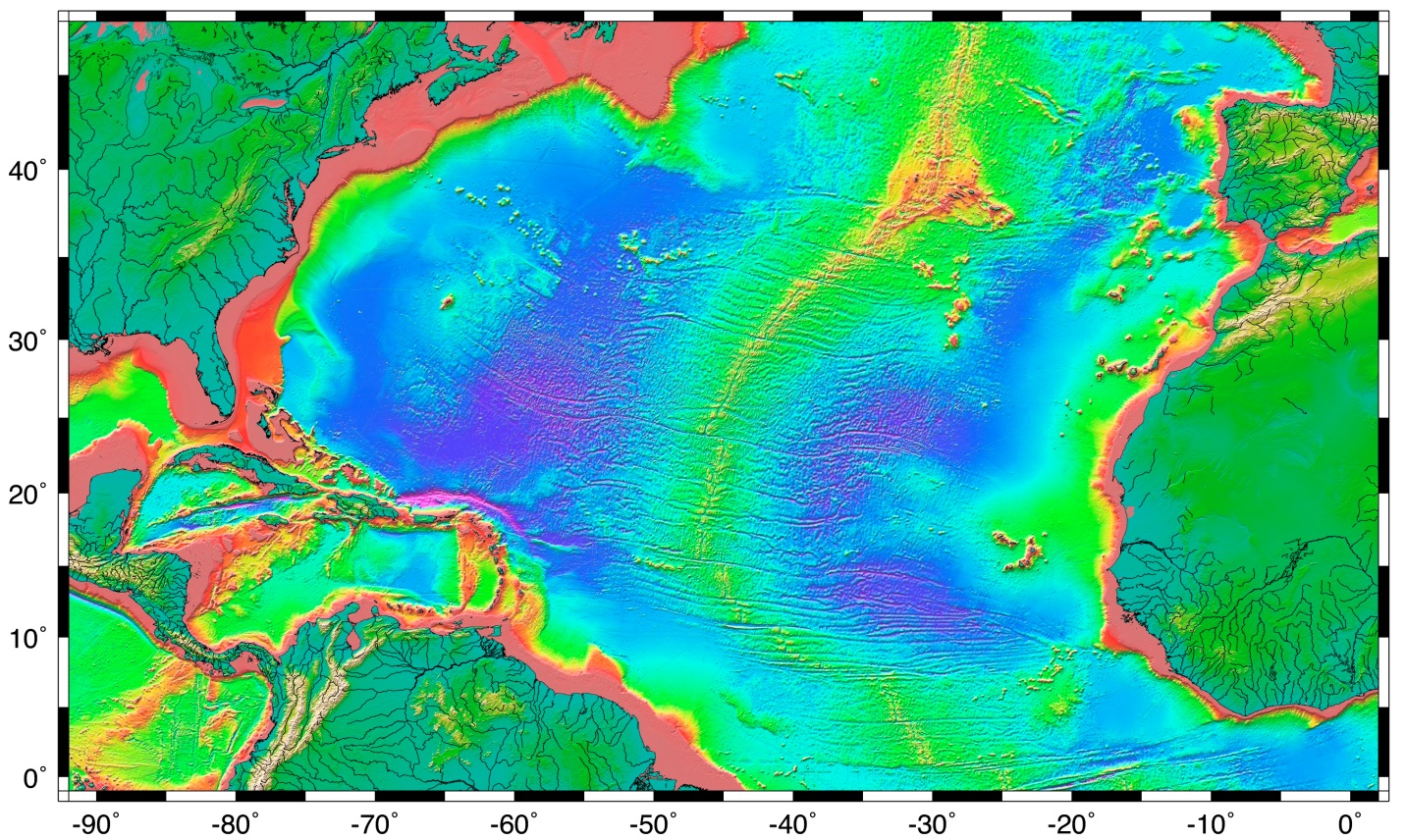
Of course, it is more complicated than this, even in this simplified form. Figure 8.4.2 shows a generalized cross-section of the Pacific Ocean which has short continental shelves that quickly turn to continental slopes, dropping from about 200 m to several thousand meters over a distance of a few hundred kilometers. The continental slopes connect to abyssal plains – exceedingly flat and from 4,000 m to 6,000 m deep; volcanic seamounts and islands; and trenches at subduction zones that are up to 11,000 m deep.
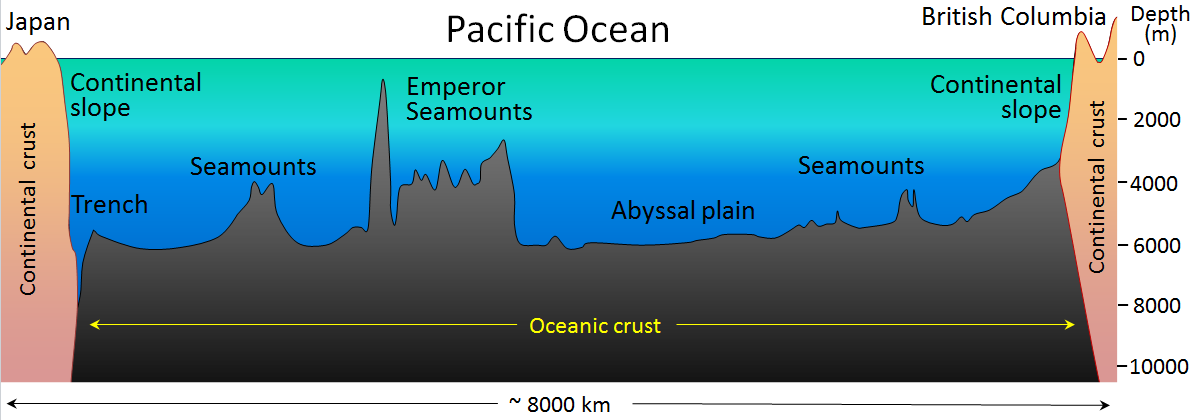
The ocean floor is entirely underlain by mafic oceanic crust, while the continental slopes are underlain by felsic continental crust (mostly granitic and sedimentary rocks). Moreover, the denser oceanic crust floats lower on the mantle than continental crust does, and that is why oceans are oceans. Although the temperature of the ocean surface varies widely, from a few degrees either side of freezing in polar regions to over 25°C in the tropics, in most parts of the ocean, the water temperature is around 10°C at 1,000 m depth and about 4°C from 2,000 m depth to the bottom. (4)
The deepest parts of the ocean are within the subduction trenches, and the deepest of these is the Marianas Trench in the southwestern Pacific (near Guam) at 11,000 m. Other trenches in the southwestern Pacific are over 10,000 m deep; the Japan Trench is over 9,000 m deep, and the Puerto Rico and Chile-Peru Trenches are over 8,000 m deep. Shallow trenches tend to be that way because they have significant sediment infill. There is no recognizable trench along the subduction zone of the Juan de Fuca Plate because it has been filled with sediments from the Fraser and Columbia Rivers. (4)
Landforms of Coastal Erosion
Large waves crashing onto a shore bring a tremendous amount of energy that has a significant eroding effect, and several unique erosion features commonly form on rocky shores with strong waves. When waves approach an irregular shore, they are slowed down to varying degrees, depending on differences in the water depth, and as they slow, they are bent or refracted. That energy is evenly spaced out in the deep water, but because of refraction, the waves’ energy, which moves perpendicular to the wave crests, is being focused on the headlands. On irregular coasts, the headlands receive much more wave energy than the intervening bays, and thus they are more strongly eroded. The result of this is coastal straightening. An irregular coast, like the west coast of Vancouver Island, will eventually become straightened, although that process will take millions of years. (4)
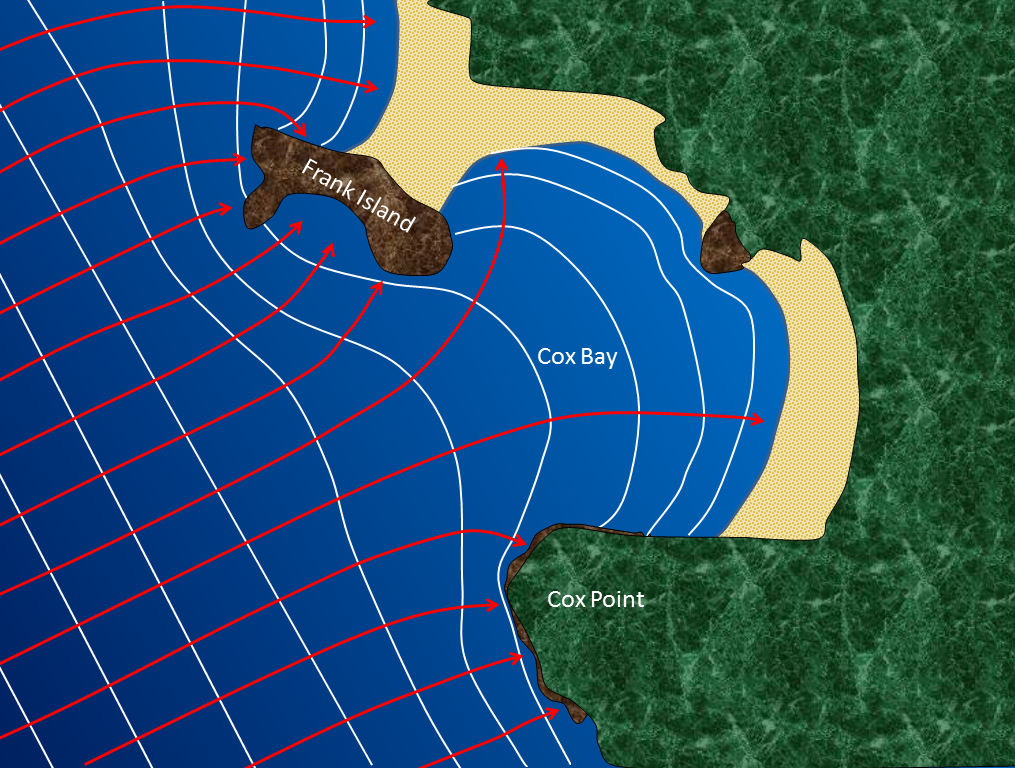
Wave erosion is highest in the surf zone, where the wave base is impinging strongly on the seafloor and where the waves are breaking. The result is that the substrate in the surf zone is typically eroded to a flat surface known as a wave-cut platform. A wave-cut platform extends across the intertidal zone. (4)
Resistant rock that does not get eroded entirely during the formation of a wave-cut platform will remain behind to form a stack. Here the different layers of the sedimentary rock have different resistance to erosion. The upper part of this stack is made up of rock that resisted erosion, and that rock has protected a small pedestal of underlying softer rock. The softer rock will eventually be eroded, and the big rock will become just another boulder on the beach.
Arches and sea caves are related to stacks because they all form because of the erosion of non-resistant rock. (4)

Submarine Canyons
Submarine canyons are narrow and deep canyons located in the marine environment on continental shelves. They typically form at the mouths of sizeable landward river systems, both by cutting down into the continental shelf during low sea levels and by continual material slumping or flowing down from the mouth of the river or a delta. Underwater currents rich in sediment pass through the canyons, erode them and drain onto the ocean floor. Steep delta faces and underwater flows of sediments are released down the continental slope as underwater landslides, called turbidity flows. The erosive action of this type of flow continues to cut the canyon, and eventually, fan-shaped deposits develop on the ocean floor beyond the continental slope. (4)
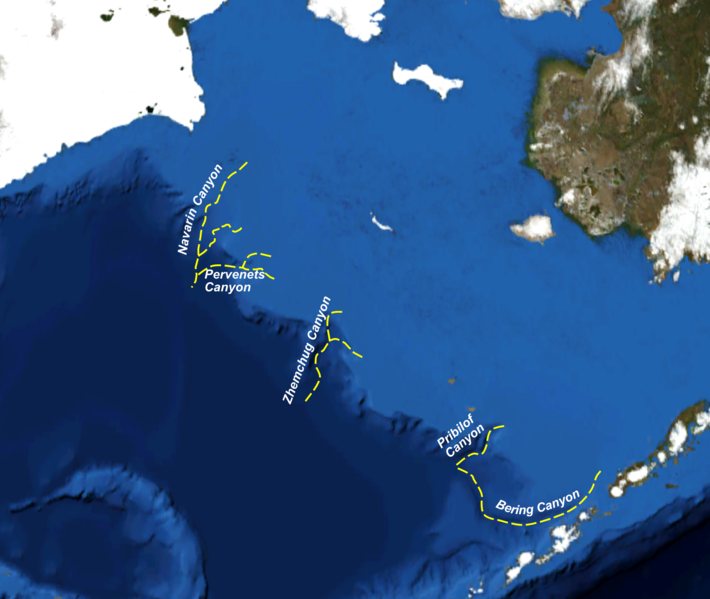
Landforms of Coastal Deposition
Some coastal areas are dominated by erosion, an example being the Pacific coast of Canada and the United States, while others are dominated by deposition, examples being the Atlantic and Caribbean coasts of the United States. However, on almost all coasts, deposition and erosion are happening to vary degrees most of the time, although in various places. On deposition-dominant coasts, the coastal sediments are still being eroded from some areas and deposited in others.
The main factor in determining if the coast is dominated by erosion or deposition is its history of tectonic activity. A coast like that of British Columbia is tectonically active, and compression and uplift have been going on for tens of millions of years. This coast has also been uplifted during the past 15,000 years by isostatic rebound due to deglaciation. The coasts of the United States along the Atlantic and the Gulf of Mexico have not seen significant tectonic activity in a few hundred million years, and except in the northeast, have not experienced post-glacial uplift. These areas have relatively little topographic relief, and there is now minimal erosion of coastal bedrock. (4)
On coasts dominated by depositional processes, most of the sediment being deposited typically comes from large rivers. An obvious example is where the Mississippi River flows into the Gulf of Mexico at New Orleans; another is the Fraser River in Vancouver. No large rivers bring sandy sediments to the west coast of Vancouver Island, but there are still long and wide sandy beaches there. In this area, most of the sand comes from glaciofluvial sand deposits situated along the shore behind the beach, and some come from the erosion of the rocks on the headlands. (4)
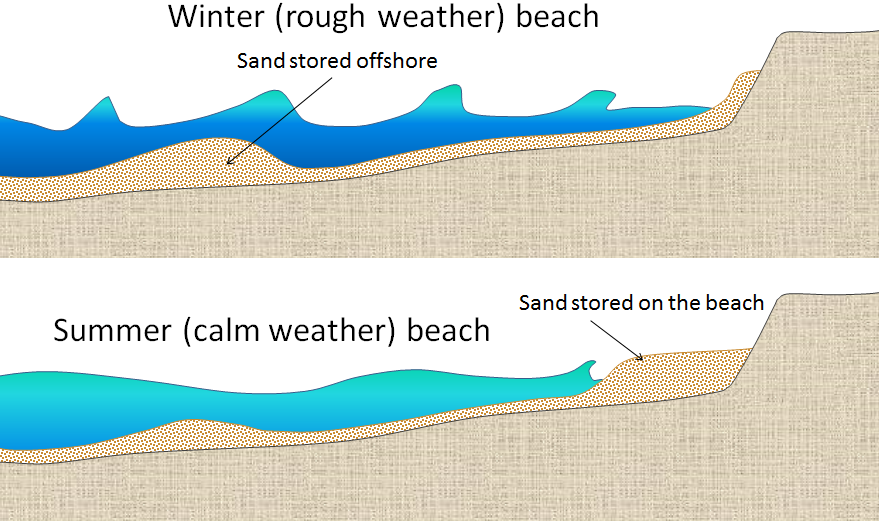
Most beaches go through a seasonal cycle because conditions change from summer to winter. In summer, sea conditions are calm with long-wavelength, low-amplitude waves generated by distant winds. Winter conditions are rougher, with shorter-wavelength, higher-amplitude waves caused by strong local winds. As seen in Figure 8.4.7, the heavy seas of winter gradually erode sand from beaches, moving it to an underwater sandbar offshore. The gentler waves of summer gradually push this sand back toward the shore, creating a broader and flatter beach. (4)

The evolution of sandy depositional features on seacoasts is primarily influenced by waves and currents, especially longshore currents. As sediment is transported along a shore, either it is deposited on beaches, or it creates other depositional features. For example, a spit is an elongated sandy deposit that extends out into open water in the direction of a longshore current. (4)
A spit that extends across a bay to the extent of closing, or almost closing it off, is known as a baymouth bar. Most bays have streams flowing into them, and since this water must get out, rarely, a baymouth bar will completely close the entrance to a bay. In areas where there is sufficient sediment being transported, and there are nearshore islands, a tombolo may form.
Tombolos are common where islands are abundant, and they typically form where there is a wave shadow behind a nearshore island. This becomes an area with reduced energy, and so the longshore current slows, and sediments accumulate. Eventually, enough sediments accumulate to connect the island to the mainland with a tombolo. (4)

In areas where coastal sediments are abundant and coastal relief is low (because there has been little or no recent coastal uplift), it is common for barrier islands to form. Barrier islands are elongated islands composed of sand that form a few kilometers away from the mainland. They are common along the US Gulf Coast from Texas to Florida, and along the US Atlantic Coast from Florida to Massachusetts. North of Boston, the coast becomes rocky, partly because that area has been affected by a post-glacial crustal rebound. (4) Barrier islands do an excellent job of blocking incoming storm surges from hurricanes, but since they are made almost entirely of sand they shift and move with every storm event. Though they are largely unstable for building and infrastructure, many people live on barrier islands and have to regularly face coastal hazards. The 2000 U.S. Census estimates that there are 1.4 million people living on barrier islands, with a population density of three times that of the coast.
Key Takeaways
Tectonic activity, sea level changes, and force of waves influence the physical structure and landforms of the coast.
The zone bordering a continent and extending to a depth, usually around 100 FM (183 m), from which there is a steep descent toward greater depth.
flat seafloor covered in sediment at great depth in the ocean (3,000-6,000m)
the slope between the outer edge of the continental shelf and the deep ocean floor.
Originating from an iron and magnesium-rich magma/lava composition.
A type of rigid, thin crust made of iron and magnesium rich minerals that is found beneath the planet's oceans.
originating from a feldspar and silica-rich magma/lava composition.
Thick crustal material mostly made of feldspar and silica rich minerals which forms the world's large landmasses.
A felsic, intrusive rock with coarse-grained texture. Granite composes mountain cores and can be found on and within the continental crust.
rocks that cement together from weathering products, either from sediments or chemical ions in water.
A hot interior layer of solid rock between the crust and core that is capable of plastic flow. The mantle is the largest layer of Earth.
The process in which the older, denser tectonic plate at a convergent boundary will buckle and sink into the lithosphere. This plate will always be composed of oceanic lithosphere.
a narrow piece of land that projects from a coastline into the sea
process of the headlands being cut back and the flanking beaches being widened
gently sloping rock ledge that extends from the high-tide level at the steep-cliff base to below the low-tide level
a large stone tower, separated from the main shoreline
elongated sandy deposit that extends out into open water in the direction of a longshore current.
A spit that extends across a bay to the extent of closing, or almost closing it off
where there is a wave shadow behind a nearshore island. This becomes an area with reduced energy, and so the longshore current slows, and sediments accumulate. Eventually, enough sediments accumulate to connect the island to the mainland

